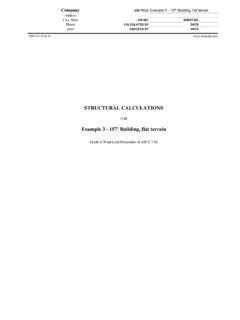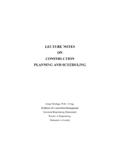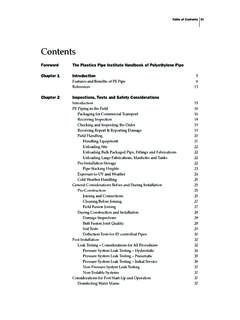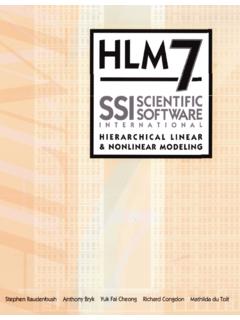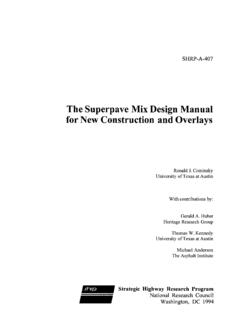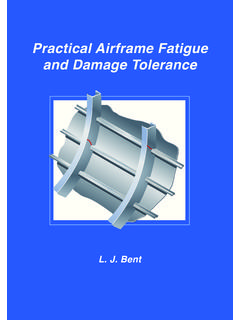Transcription of Analyzing and Interpreting NMR Spin-Spin Coupling ...
1 Research: Science and Education156 Journal of Chemical Education Vol. 84 No. 1 January 2007 pedagogical value of computational chemistry in thechemistry curriculum, in particular the value of first-prin-ciples calculations of NMR chemical shifts (1, 2), has beenpreviously pointed out in this Journal. Emphasis has beenput on providing recipes for addressing well-defined prob-lems computationally and on comparing experimental withcalculated data. These are important ingredients that can en-able students to support their future (usually experimental)graduate research projects with their own calculations, to geta feeling about the accuracy that can be achieved, and to beable to assess the quality of published theoretical data. Quan-tum chemistry is now a component of many graduate researchprojects. Introducing students to the power and the limita-tions of quantum chemical methods, and to the theoreticalbackground, is therefore an important aspect of a modernchemistry spectroscopy is one of the most important experi-mental techniques since it is able to provide useful informa-tion about the electronic and geometric structures of a widevariety of systems investigated in organic and inorganic chem-istry.
2 Additionally, theoretical methods have been used ex-tensively to compute chemical shifts and spin spin couplingconstants from first-principles theory. (See refs 3 10 for aselection of available review articles.) A comprehensive over-view of computational methods for magnetic resonance pa-rameters has also recently become available (11). With thehelp of calculations, it is possible to simulate NMR spectra,propose data for yet unknown substances, get detailed in-sight into the mechanisms that determine the experimentaloutcome, and so NMR spin spin Coupling constants, also knownas J Coupling constants, provide a wealth of structural infor-mation as well as detailed insight into the bonding of an atomto its neighbors. In this article, we show how density func-tional theory (DFT) calculations of J couplings can help toclarify the relation between such properties and the electronicstructure and bonding in molecules. This is achieved by theanalysis of J Coupling in terms of contributions from mo-lecular orbitals (MOs), localized molecular orbitals (LMOs),and fragment orbitals (FOs).
3 We should point out that suchanalyses for organic (12 17) and inorganic systems (18 22)are also an active research topic. Here, we apply an orbitalanalysis to one-bond carbon carbon Coupling , J(C,C), inethane, ethene, and ethyne. The C C Coupling constantsin the aromatic molecule benzene as well as C H couplingsfor all molecules are also discussed. We show how a graphi-cally-oriented approach, combined with hard numericaldata, can lead to a better understanding of the nature of Jcoupling and of the orbital description of the electronic struc-ture of molecules. In addition, we use the concept of local-ized molecular orbitals and apply it to rationalize themagnitudes of the C C Coupling constants. Unlike the usual MOs, these orbitals are the theoretical equivalent ofthe bonds and lone pairs (and core shells) of the Lewis for-mula of a molecule. Unfortunately, they are not prominentlydisplayed in most the best of our knowledge, NMR spin spin couplingcomputations and orbital analyses based thereupon have notyet been discussed in this Journal.
4 We believe that the mate-rial will be most useful in a course about NMR spectroscopyor as a computational exercise as part of a computationalchemistry or molecular modeling course. It is now possibleto compute NMR spin spin Coupling constants rather accu-rately with inexpensive DFT methods. This makes a studyof small molecules attractive for use in a classroom or forhomework. We hope that this article will be beneficial to awider range of courses since the concepts used here can beapplied to analyze other properties as well (see Appendix A,Table 8, in the Supplemental MaterialW for a list of such prop-erties). A computational analysis of trends in J couplings mightalso be suitable as a computational undergraduate or gradu-ate research project ( , if applied to a different set of mol-ecules). Course prerequisites depend on the level at which aninstructor teaches a particular course. Introductory physics andsome basic knowledge of NMR spectroscopy as acquired inundergraduate organic chemistry classes will be essential.
5 Aqualitative explanation of J Coupling at this level is given inthe first half of the second section. Basic quantum theory astaught in undergraduate physical chemistry courses will berequired to make use of the quantum theory of J Coupling ,which is outlined in the Appendix in the This theory supports the arguments regarding thes character of bonds presented in the second half of the sec-ond section. However, more qualitative explanations mightbe chosen instead. We do not think that prior experience withcomputational chemistry is necessary for the calculations pre-sented in the third section, though of course it would be help-ful. Based on these calculations, we apply various analysisconcepts to the J Coupling in ethane, ethene, ethyne, and ben-zene in the third section. Here, we make use of molecular or-bital plots. Some experience with qualitative molecular orbitaltheory will be required to use these and Mechanisms of J CouplingFor further details regarding the material presented inthis section we refer to refs 23 and Dipole MomentsMoving charged particles (electrons, nuclei) represent anelectric current, which is the source of a magnetic field.
6 Inparticular, electric ring currents are the source of a magneticfield equivalent to that of a magnetic dipole (Figure 1). Inturn, a magnetic field will induce electric ring currents1 withan associated magnetic dipole moment in a system of chargedparticles (atoms, molecules). Analyzing and Interpreting NMR Spin Spin CouplingWConstants Using Molecular Orbital CalculationsJochen Autschbach* and Boris Le GuennicDepartment of Chemistry, State University of New York at Buffalo, Buffalo, NY 14260 3000; Science and Vol. 84 No. 1 January 2007 Journal of Chemical Education157 When considering a single rotating charged particle, themagnetic moment m is proportional to its angular momen-tum L. The constant of proportionality is the magnetogyricratio , that is, m = L. For instance, for the orbital rota-tional motion of an electron, we have e = e (2me), where eis the electronic charge and me is the mass of the and Magnetic MomentThe property spin is an angular momentum of an el-ementary particle.
7 Spin is often incorrectly interpreted as theparticle s intrinsic rotation. However, according to the previ-ous paragraph this analogy from classical physics illustrateswhy there must be a magnetic moment associated with thespin angular momentum of a charged particle. Atomic nu-clei with an odd mass number or with an odd number ofneutrons have a nuclear spin angular momentum (usually la-beled I, not L). Thus, nuclei with nonzero spin are tiny mag-nets. The orientation of the spin vector and therefore theorientation of the magnetic moment with respect to a refer-ence axis is quantized and described by the spin quantumnumber I. For a nuclear spin quantum number I, there are2I + 1 possible orientations. The length of the I vector is[I(I + 1)] 1/2 . The magnetic moment of a nucleus A is pro-portional to its spin angular momentum IA and is given byAAAmI= (1)The constant of proportionality, A, is called the nuclear mag-netogyric ratio. For atomic nuclei it is determined from ex-periment rather than calculated also have a spin angular momentum S withan electron spin quantum number of S = 1/2.
8 The magneto-gyric ratio S for the electron spin magnetic moment mS isapproximately twice that for the orbital motion, that is, S =ge e, with ge being the g factor of the electron. If anatom or a molecule has all orbital levels doubly occupied thereis no net electron spin magnetic moment present (other thanthe tiny induced magnetic moments due to the presence ofmagnetic nuclei as will be discussed below). We will restrictthe discussion to such systems of Magnetic Dipole Moments and MagneticFieldsThe interaction energy of a magnetic dipole moment mwith a magnetic field B is given asEmBmBmBxxy yzzmB = = ++()(2)Owing to the negative sign, the energy E is lowest if the ori-entation of the magnetic field and the magnetic dipole areparallel; it is highest if their orientation is antiparallel. Thisis the mechanism that keeps a compass needle aligned withthe Earth s magnetic a nuclear spin represents a tiny magnet it will alsoadopt an orientation relative to a magnetic field in such away as to minimize its energy.
9 The main difference betweena nuclear spin and a compass needle is that the possible ori-entations of the nuclear magnetic dipole with respect to themagnetic field direction are quantized. One of the 2I + 1 pos-sibilities will correspond to the parallel orientation and thusbe lowest in energy; the other orientations have higher ener-gies. Transitions between these energy levels require a spe-cific quantized amount of energy. This forms the basis ofnuclear magnetic resonance (NMR).Nuclear Spin Spin Coupling and NMRC onsider two magnetic nuclei A and B in a nucleus A is the source of a magnetic field, the othernucleus B will behave like a quantum compass needle inthis magnetic field. This results in a set of quantized orienta-tions with quantized energy levels for this nuclear spin. Aphenomenological energy expression that describes the en-ergy of interaction between the two nuclei isEABABAmKD =,()+,())=,()+,(),,,,mBixyz=,,j=yzxAiiji jBjmKABDABm(3)The two 3 3 matrices K and D relate the interactionof the x, y, z component of one nuclear spin magnetic mo-ment to the x, y, z component of the other nuclear spin mag-netic moment.
10 They mediate the strength of the nuclearinteraction; for example, they depend on the distance betweenthe two nuclei, the relative orientation of their spins, and inthe case of K on the details of the molecule s electronic struc-ture. D is the dipolar Coupling tensor and yields the interac-tion energy between the two nuclei in the absence of electrons(through space Coupling ). K is called the reduced indirectspin spin Coupling tensor that describes the interaction of thenuclei through their interactions with the electrons of the mol-ecule. In solution or gas phase where molecules can rotatefreely, the dipolar Coupling averages to zero (25) and onlythe indirect Coupling can be observed easily. Therefore, wewill only consider indirect spin spin Coupling spin spin Coupling takes place independent ofwhether there is an external magnetic field present or , it is most conveniently detected via the fine struc-ture of NMR spectra and thus often called NMR spin spincoupling.



